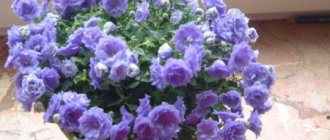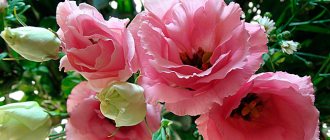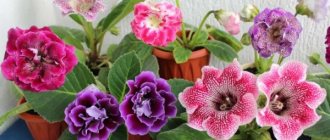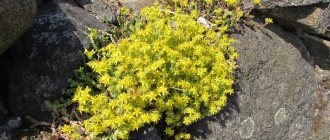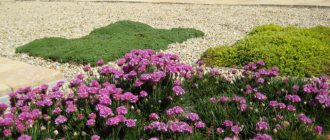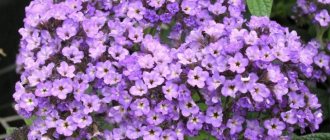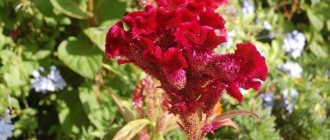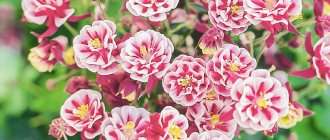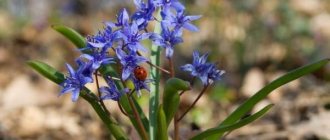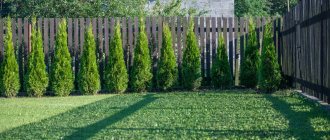Aquilegia is a flower that is popularly called elf's slipper, columbine, eagle or dove, and is often mentioned in myths and fairy tales. Such unusual names were assigned to the plant due to the originality of the flower shape. Truly unusual, unlike anything else, aquilegia flowers will decorate gardens located in the northern hemisphere. In other parts of the world, decoratively bred hybrid varieties are used for landscape design.
Aquilegia, most often called columbine, is a herbaceous perennial from the ranunculaceae family. The main habitat is the mountainous regions of the northern regions.
catchment area
Description of the plant
The original perennial columbine flower, which has not been subjected to selection, is a low plant, reaching 30 cm during the growing season. But during flowering, under favorable weather conditions, it can grow up to 1 m. Moreover, the stems can fall to the ground.
In most cases, the flower lives for 2 years. In the first year of its development, it forms a bud for a flowering shoot, which is thrown out at the beginning of summer. By autumn, a small rosette of leaves forms, dying and overwintering. In the second year, last year's leaves are replaced with new ones.
Aquilegia in a flowerbed
Single flowering - one drooping flower is formed on a flexible flowering stem. The description of the plant would be incomplete without mentioning that the petals of an alpine flower can have a variety of colors - white, red, yellow, crimson, blue, as well as a combination of several colors.
The corolla is 5 petals, located separately from each other. They form a kind of funnel, in which a wide hole is cut obliquely. It is noteworthy that in addition to the main petals, the flower has spurs. They are longer and narrower, curved towards the stem.
Important ! It is the length of these spurs, as well as the intensity of their twisting, that scientists use to classify aquilegia.
Some varieties of aquilegia form panicles of flowers, unlike the single flowering plant that grows in the wild.
After flowering, the aquilegia fruit is formed. It is a multileaf (pod-like fruit) with black shiny seeds.
Note! The seeds of the plant are poisonous and retain intensive germination for 1 year.
Care
The catchment or water intake is an unpretentious plant. It will not require close attention and care. The plant grows well in partial shade, but it is important that the sun shines into the flowerbed at least a few hours a day. The culture has a well-developed root system in the form of a tap root. It goes deep into the ground, so watering may not be frequent when caring for aquilegia.
The soil
Aquilegia or catchment prefers sandy soils, loose, breathable soil.
The plant does not tolerate crowding or proximity to weeds, so the ground must be constantly cleared of weeds and loosened. In mature bushes, roots appear on the surface of the soil in autumn. It is advisable to sprinkle them with peat mixture or leaf compost. Get ready to constantly fight self-seeding. The catchment scatters seeds and germinates quickly.
Temperature and lighting
Do not plant aquilegia seedlings in an open space where the hot sun shines all day long.
From the heat and bright light, the buds of the crop become smaller and the leaves dry out. It’s better to find an area where at certain times shadows from buildings or neighboring trees fall on the flowerbed. The plant does not like drafts.
Watering
Aquilegia needs to be watered regularly, but if you suddenly forget to do this, the plant will not die, but will use reserves from the powerful root. Unlike many other flowering plants, columbine loves to be given a "shower". It is better to water from a hose with a shower head attached to the end.
Fertilizers and fertilizing
In the spring, when the first leaves appear on the bush, you can feed it with nitrogen fertilizer. This fertilizer is no longer used during the summer. For an elegant beauty, buy complex mineral compositions with a predominance of phosphorus. This will help improve the quality of flowering.
Blooming aquilegia
After the bush has flowered, it is fed with potassium fertilizer.
Transfer
Aquilegia does not tolerate moving from one place to another very well. After replanting, the plant begins to hurt and sometimes dies completely.
You should absolutely not disturb a flowering bush - the aquilegia will drop its flowers.
If, after all, replanting is inevitable, then you need to dig up the bush from all sides, carefully remove it from the soil and transplant it into a new hole along with a lump of earth.
Trimming
Preventive pruning can be carried out in winter and throughout the summer season. By removing excess shoots, you create conditions for the growth of strong branches. Dry flower stalks should also be removed with sharp pruning shears. Then the bush will not only have an aesthetic appearance, but also the aquilegia flowers will not have time to ripen into seeds and scatter them around the area.
Aquilegia: planting and care in open ground
Aquilegia - growing from seeds
It must be borne in mind that common aquilegia blooms for 2 years. Flowers are produced intensively from early June to early August.
Aquilegia has become quite often used in the design of flower beds and lawns. If you choose the right height of the plant, you can use it to decorate landscape alpine slides. It is most suitable for mixing with other plants. After all, its natural distribution area is mountainous regions. Therefore, you just need to pay attention to your companion plants - and the result will surprise and delight even the most demanding aesthetes.
As for tall plants, they look better when planted closely in one place. You should not plant aquilegia in a row, as tall representatives of this genus can simply overwhelm the flower stalks from strong winds or heavy rainfall.
Tall aquilegia in combination with other flowers
The main thing is to choose the right variety and then flowers of a certain color, shape and size will be able to decorate any flower bed. In particular, you need to pay attention to the height of the peduncle so that it does not drown out its neighbors and does not get lost among them.
How to care for your watershed
It is necessary to systematically loosen and weed the soil. We must remember about watering. But the common aquilegia is unpretentious to water and can withstand dry conditions well.
Feeding will not be superfluous; it should be carried out 1-2 times a year. Organic or mineral fertilizers can be used as fertilizing.
It is also recommended to annually add fresh fertile soil under the aquilegia.
Growing a watershed in one area for more than 5 years is not recommended. After all, this can contribute to the formation of hybrids and reduce the decorative appearance of the flower. To prevent this situation after the aquilegia has flowered, you need to remove the flower stalks. The resulting seeds should be planted at a distance.For earlier flowering it is necessary to use forcing. This agrotechnical technique is as follows: with the onset of autumn, it is necessary to transplant the rhizomes of aquilegia into ordinary pots or special flower containers.
Next, they must be placed in a dark room and left there until cold weather sets in. For the winter, the containers must be moved to a cold place. This could be a basement or a cold greenhouse. The plants should remain there until the end of January.
Then they should be placed in a warm, well-lit place. For growth and formation of flower stems, it is necessary to maintain 12-16 ° C. If all rules are followed, the plant will bloom in early April.
How long does aquilegia bloom?
Monstera flower - what the plant and leaf look like
Under favorable conditions, a suitable amount of sunlight, and the proper level of humidity, this plant is able to delight the eye with its delicate and sophisticated flowers almost throughout the entire summer.
Note! But it is worth remembering that the hotter it is and the more sunlight, the smaller the flowers become, and the flowering period is significantly reduced.
If you want your aquilegia to produce intense flowering, then you should take care of planting and caring for it in open ground according to the following rules:
- It is better to choose partial shade. Otherwise, in strongly illuminated areas, the flowers will be smaller in size, and the flowering period may be reduced to 1 month;
- the soil should be moderately moist. To do this, it is necessary to water the plants as the top layer of soil dries. It is also worth taking care of timely loosening - this will ensure the necessary flow of oxygen into the soil. In order for the soil to become light, as aquilegia loves, it is necessary to add humus to it. Feeding is carried out with standard mineral supplements suitable for flowering plants.
Landing
Aquilegia reproduces in two ways:
- Seminal
- Vegetative
Before planting any plant, you need to take care of the conditions for normal growth and development. Although the columbine is an unpretentious flower, it is no exception.
Choosing a place and soil for planting in open ground
Aquilegia likes to grow in partial shade. In the sun it will have smaller flowers and the flowering period will be shorter. Only two species are sun-loving: alpine and fan.
The catchment is undemanding to the soil. Despite this, before planting it needs to be prepared: dig it up and add fertilizer. You can use humus or compost.
If the soil in the garden is clayey, you need to add river sand or crushed stone.
The most optimal time for planting is early spring or early autumn . A plant planted during this period will take root faster and suffer less pain.
It is better not to plant Aquilegia of different varieties in the same flowerbed. They don't like this neighborhood. Plants will take a long time to take root. The risk of cross-pollination also increases, as a result they may lose their species characteristics.
Planting a seedling
When the place is prepared, you can begin planting the seedling. You can buy it at a nursery, dig up a self-seeded plant, or divide an existing bush.
Planting plants in open ground
If the choice fell on a seedling, from the garden or taken from friends, it needs to be examined for health. Aquilegia is susceptible to harmful insects and plant diseases. It should have clean and even leaves. It is mandatory to check for stains on them.
When replanting an adult plant, carry it with a clod of earth. Three or four year old aquilegia does not tolerate moving well. You must try not to damage the root. Such plants are not suitable for propagation by division. They can be propagated by seeds or cuttings.
For dividing the bush, a watershed no older than two years is suitable. The period at the end of summer or beginning of autumn is suitable for this.
Step-by-step description of the procedure:
- Cut off the ground part of the aquilegia. Leaving about 5 cm.
- Carefully dig up the bush, being careful not to damage the root system . The root goes deep into the core, we must not forget about this.
- Rinse the root.
- Divide so that each part has a part of the central root with lateral shoots and several renewal buds.
- Plant all parts in the shade or consider temporary protection from the sun . This will ensure less painful aquilegia.
- Regular watering is needed until late autumn. At the same time, you should not overfill and allow water to stagnate.
If the cutting method is chosen, it is carried out in early spring. Until the plant opens its leaves:
- A shoot with a piece of root is cut out . It is also called the heel.
- Treat it with a root formation stimulator.
- Plant in fertile soil mixed half with sand or in sand.
- Build a greenhouse over the planted cuttings . You can cover each with a glass jar or a cut plastic bottle.
- The cover cannot be removed for 10 days, even for watering . After this period has expired, rare ventilation can be carried out. The greenhouse is removed after a month.
- During this time, a full-fledged root system will be formed . The bushes can be moved to a permanent place in the flowerbed.
Seed method
Aquilegia seeds have good germination as long as they are fresh . It is recommended to plant them immediately after they have been collected. If this is not possible, then they need to be stored in a cool place. They cannot be stored for more than a year.
Seeds collected from a hybrid plant may lose the qualities possessed by the mother plant . For example, the color of the petals or their doubleness.
Aquilegia seeds
In autumn, the seeds are sown directly into the ground . Scatter the seeds onto the surface of the finished bed. Press them slightly into the soil and moisten. There is no need to bury them deeply. Sprouts will appear in the spring, after the snow melts. Flowering occurs in the second year.
Aquilegias planted in this way have greater endurance than those propagated by other methods.
When planting in spring, you must first grow seedlings . If you plant them immediately in the ground, they will take a long time to sprout. Perhaps only next year the first shoots will appear.
Step-by-step instruction:
- Before planting seedlings, the seeds must be stratified . To do this, mix the seeds with the substrate and sand, moisten. Wrap in a plastic bag and put in the refrigerator. The period of such exposure is a month.
- Then remove and keep at a temperature no higher than 18 degrees until planting on the site . It is necessary to provide good diffused lighting. The room must be regularly ventilated to avoid the greenhouse effect. Do not keep containers with seedlings near batteries. As the soil dries, it needs to be moistened by sprinkling with water.
- When 2 - 3 full-fledged leaves grow, you need to dive into separate pots.
- Planting takes place at the end of April or beginning of May. The distance between the bushes should be about 40 cm.
- At home, difficulties may arise with lighting and temperature . If these conditions are not met, the seedlings will become stunted.
If you have stored aquilegia seeds for more than 12 months and you want to try planting them, then you need to carry out a procedure to increase germination. To do this, you need to pour them onto a smooth, hard surface and rub them with sandpaper. Then treat with a growth stimulator. Although this method does not provide guarantees.
Aquilegia Terry
Aquilegia Terry is an unusual variety of plant, which is distinguished by its largest flowers, reaching a diameter of 10 cm. It was bred artificially in order to diversify the flowers and achieve a certain effect.
A distinctive feature is its multi-petal structure. The flower itself is formed from narrow petals arranged in several rows. When it comes to coloration, the intensity of the color decreases as it approaches the center. Shades can range from white to lilac.
The leaves of this plant variety have a specific bluish coating.
Note! When breeding Aquilegia Takhrova, breeders managed to achieve higher frost resistance. This makes it possible to grow a plant of this variety in regions more northern than its natural distribution area.
This is what ensured the great popularity of the variety among gardeners.
Aquilegia Terry
Aquilegia Hybrid
The name itself indicates that breeders have worked to improve both the shape and size of the flower, and the versatility of its color. Breeders managed to achieve such results by crossing the watershed of an Alpine and an American plant variety.
Aquilegia hybrid is distinguished by its tall growth - shoots can reach 1 m in height. And the flowers themselves are quite large - up to 10 cm in diameter. If we talk about the number of flower petals of this variety, they can be standard - 5 main ones and 5 spurs. In other variations of the variety, the number of petals can be significantly greater and thus form a double or fan-shaped flower.
The most common color options are a combination of white with blue or red. Monochromatic coloring of the peduncle is also common.
Important ! If you want to get an abundant flowering cap on your flowerbed or lawn, then you should choose hybrid aquilegia, as they are distinguished by abundant simultaneous flowering, which lasts quite a long time.
This variety is also suitable for growing in more northern regions than it usually grows - it is quite frost-resistant and unpretentious in care.
Aquilegia Hybrid
Aquilegia vulgaris
The usual distribution area of this flower is in the European part of the Eurasian continent.
It differs in height, ranging from 30 to 70 cm - depending on the conditions that exist in a certain region or season.
The main part of the leaves of the variety are located at the base of the petiole and leaves are much less common along the length of the stem. They are double trifoliate, with a slight bluish coating.
Note! Flowers of this variety are distinguished by the fact that they have a small variety of petal colors. Most often these are blue, purple and pink shades.
If we talk about the size of the peduncle, then it is quite average in size. Only 4, maximum 5 cm in diameter. As for the number of petals, they can be standard and include 5 main and 5 spurs. Other variations include double flowers.
Important ! This variety can withstand frosts that last quite long and with temperatures down to -35°C. Therefore, it can be planted even in regions where winter temperatures are quite extreme or in areas that are high above sea level.
It is all of the above characteristics of this variety of aquilegia that make growing and caring for it quite easy.
Aquilegia vulgaris
Reproduction
Due to the fact that aquilegia has a thick root that goes deep into the ground, dividing and replanting the flower is quite problematic. Therefore, the plant is most often propagated by sowing seeds.
Watershed seeds remain viable for two years.
If there are several varieties growing on your site, there is a high probability of cross-pollination. Seedlings will produce a variation in flower height and color.
Dominant features:
- Blue colour,
- wide petals and sepals,
- medium length spurs.
Aquilegia Winky
It is most often used to decorate the garden in landscape design, for interiors (as balcony flowers) or as a potted flower.
A distinctive feature of Aquilegia Vinki is a fairly compact bush, reaching a height of no more than 20-30 cm.
At the end of the stem, 20 cm long, there is one flower, which most often is a double combination of petals complemented by spurs. Coloring varies from single-color petal options to a combination of several shades.
Such aquilegia at the dacha allows you to quite effectively decorate not only flower beds, but also the facade of the building, as designers suggest planting it in hanging pots.
Aquilegia Winky
Diseases and pests
Under the right conditions, aquilegia practically does not get sick . But if the maintenance conditions are violated, the flower may show signs of development of powdery mildew, rust or gray rot .
Unfortunately, there are no effective means to 100% get rid of gray rot. The affected parts are simply removed from the bush; in case of extensive lesions, it is dug up and burned.
Powdery mildew can be cured by regular treatments with colloidal sulfur solution.
Preparations containing sulfur will help against rust.
Among the pests that parasitize the catchment area are:
- spider mite;
- scoop;
- aphid;
- nematode.
The use of insecticides will help get rid of parasites.
Aquilegia Yellow
Another perennial plant hybrid is the Yellow Aquilegia variety. Its distinctive feature is golden flowers of a single color, which have a fairly standard shape, characteristic of a wild-growing catchment. This species is popular in North America, but recently it has become increasingly in demand among domestic gardeners. This is due to the fact that bright flowers of a rich yellow hue begin to bloom quite early and continue to send out flower stalks abundantly throughout the summer.
As for growing regions, it feels best in regions with a temperate continental climate.
Aquilegia Yellow
Growing aquilegia from seeds
It is recommended to sow seeds in open soil as soon as the seeds are collected. In spring, the emerging seedlings can be transplanted to a permanent location. However, if sowing is planned for the spring, then a place with a low temperature should be chosen for storing seeds. To ensure that the germination rate of seeds does not decrease in winter, it is recommended to mix them with soil and place them on the refrigerator shelf. In March, the seeds should be washed from the soil and sown in boxes, which should be filled with a light substrate consisting of sand, humus and leaf soil (1: 1: 1), it should be compacted well and watered. The seeds distributed over the surface of the substrate must be sprinkled with a three-millimeter layer of soil, which must be passed through a sieve. The top of the container should be covered with burlap or a sheet of newspaper. Place the container in a shaded place where the temperature is between 16–18 degrees. If necessary, it is necessary to moisten the surface of the substrate using a sprayer. The first shoots can be seen in 7–14 days. After the first pair of true leaves forms on the plant, it should be planted in loamy soil saturated with nutrients (this occurs in the last days of April, the first days of May).
Aquilegia Columbine
This is a perennial with a compact but fairly tall bush - up to approximately 70 cm. The variety is cold-hardy, which makes it, like Aquilegia Ordinary, a suitable species for growing in the Siberian regions.
A distinctive feature of Aquilegia Columbina is its more elongated flower shape, reminiscent of a bell-shaped bowl. The shades of the petals can vary from the lightest (white) to deep dark purple.
Aquilegia Columbine
Using a catchment to decorate your garden
The flower is an excellent component of group flower plantings:
- in the alpine slides;
- on lawns;
- under the trees;
- along the banks of artificial reservoirs;
- in ridges, flower beds and mixborders.
The group planting method using a catchment area helps the flower not only fit well into the garden landscape, but also emphasize its unique appearance.
The plant harmonizes with hostas, gentian, and irises. Looks great with bergenia, brunnera and fern. The flower is used very rarely to decorate bouquets, because when cut, the catchment quickly fades.
Aquilegia White
White varieties of catchment look quite impressive. They can become a real decoration of the garden, especially in combination with other flowers of brighter colors.
There are several varieties of White Aquilegia, such as “Snow Queen”, “Tower white”, “White Star”.
Note! Each variety has a fairly long flowering period. Some of them can be planted in Siberia or the Urals due to their fairly efficient growth and frost resistance.
If we talk in general about how to care for this type of aquilegia, then it is as unpretentious as all the others. The main thing is to choose the right time to sow seeds or plant seedlings. And also ensure suitable conditions for humidity and soil quality
Some interesting facts about the name of the plant
The name of the flower evokes an indescribable slight sadness. Etymologists have no consensus on its origin.
The Russian word “aquilegia” goes back to the Latin Aquilegia, formed either on the basis of the phrase aqua legere (to collect water), or from the word aquila (eagle). This is where the names of the flower given to it by the people came from: columbine, orlik.
They also call it differently: boot, dove, bell. There are also almost mythical names: Venus's slipper, elf's slippers.
The plant is distributed in different parts of the world, so it is not surprising that different peoples create their own legends about aquilegia. In America and Great Britain, the flower is called Columbine due to the variability of color.
The change in its color is transferred to people’s relationships and Aquilegia is considered a flower associated with betrayal and unrequited love. On the contrary, in European countries they primarily celebrate the tenderness, almost airiness, of plants. Here the flower is considered a symbol of the Holy Spirit or angels. Such flowers often decorate the gardens of monasteries and are called the slippers of the Virgin Mary.
Aquilegia alpine
The Alpine Aquilegia variety is a small plant. It rarely reaches a height of more than 40 cm. However, if you artificially create the most comfortable conditions for growth and regularly feed it, you can grow flower stalks up to 80 cm high. However, most often the plant is quite short.
Peak flowering for this variety occurs at the beginning of June, end of July. The flower is ordinary in shape. Unpretentious to conditions.
But still, aquilegia will require specific care after flowering. In order to rejuvenate the bush, it must be replanted before it is 2 years old. Otherwise, you can damage the root system of the flower. It is also important to rejuvenate the plant to maintain an attractive appearance. This can be done by cutting down the faded peduncle.
Important ! After seven years of age, the plant withers. It stops giving color, the leaves become small and inconspicuous. Therefore, a radical rejuvenation of old bushes is required by planting new flowers. Varieties that are annuals need to be planted annually.
To summarize all of the above, it is worth noting that in landscape design, Aquilegia Columbian, Biedermeier, Hybrid, Clementine and Terry are the most popular. These are ideal plants for mixborders and alpine lawns. Due to their unpretentiousness, they easily take root and do not require intensive care or frequent fertilizing. But, it is still desirable that the plant be provided with partial shade - this way the flowers achieve the most attractive appearance and large size. In this case, it is also possible to achieve longer flowering.
Use in landscape design
In single plantings and mono-groups, the catchment area is rarely used. The beauty and elegance of aquilegia in landscape design is best revealed in the vicinity of other flowers. Low-growing varieties are planted in an open flower bed next to delphinium, gentian and saxifrage. The perennial can become a “participant” in multi-tiered compositions, as well as decorate alpine slides and act as a frame for a pond.
Aquilegia terry hybrid is a tall variety; it will look great in the center of the composition and can be used for zoning space.
It has many varieties, as breeders often use it as a basis to experiment with flower coloring. One of the common varieties is aquilegia with yellow buds that resemble a small golden ball on a long (about a meter) stem.
Among the many species, Aquilegia McCann deserves special attention. Today, many hybrids have been bred from it, which differ in stem height (up to 120 cm) and large, simply gigantic buds of different colors and shades. A distinctive feature of all bred hybrids is that their flowers almost never droop, and aquilegia blooms almost all summer. Hybrid varieties McCana are used for planting along fences, as an independent accent in flower beds, in borders and along paths.
